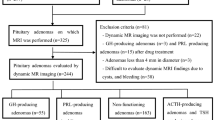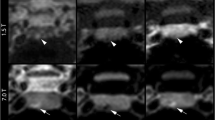Abstract
ACTH-secreting tumors represent 10% of functioning pituitary adenomas, and most of them are microadenomas. It is generally accepted that only half of these tumors are correctly identified with current magnetic resonance imaging (MRI) techniques. The objective of the paper is to report a method for detecting suspected ACTH-secreting pituitary tumors undetectable by conventional dynamic MRI using dynamic 3-Tesla MRI (3T MRI) and half-dose gadopentetate dimeglumine (0.05 mmol/Kg). Eight patients were included (5 men and 3 women) with a mean age of 29.12 years. Each of them had a confirmed diagnosis of Cushing disease and a negative dynamic MRI for microadenoma using full-dose gadopentetate dimeglumine. A second MRI was then performed using only half the usual dose of contrast material. Images from the second MRI where compared with the first study. Microadenomas were detected in 100% of the patients using a half dose of the contrast. All were recognized on the basis of the presence of a hypointense nodular lesion surrounded by normal contrast-enhanced tissue. Six patients were submitted to surgery, and the results were confirmed by immunohistochemistry in all of them. The remaining subject had a sinus sample catheterization coincident with the MRI results. Conclusion: A half dose of dynamic resonance imaging contrast material increases the sensitivity of MRI detection of ACTH-secreting pituitary tumors.


Similar content being viewed by others
References
Trouillas J (2002) Pathology and pathogenesis of pituitary corticotroph adenoma. Neurochirurgie 48:149–162
Osamura RY, Kajiya H, Takei M, Egashira M, Tobita M, Takekoshi S, Teramoto A (2008) Pathology of the human pituitary adenomas. Histochem Cell Biol 130:495–507
Testa RM, Albiger N, Occhi G, Sanguin F, Scanarini M, Berlucchi S, Gardiman MP, Carollo C, Mantero F, Scaroni C (2007) The usefulness of combined biochemical tests in the diagnosis of Cushing’s disease with negative pituitary magnetic resonance imaging. Eur J Endocrinol 156(2):241–248
Stadnik T, Stevenaert A, Beckers A, Luypaert R, Buisseret T, Osteaux M (1990) Pituitary microadenomas: diagnosis with two-and three-dimensional MR imaging at 1.5 T before and after injection of gadolinium. Radiology 176(2):419–428
Steiner E, Imhof H, Knosp E (1989) Gd-DTPA enhanced high resolution MR imaging of pituitary adenomas. Radiographics 9(4):587–598
Vallette-Kasic S, Dufour H, Mugnier M, Trouillas J, Valdes-Socin H, Caron P, Morange S, Girard N, Grisoli F, Jaquet P, Brue T (2000) Markers of tumor invasion are major predictive factors for the long-term outcome of corticotroph microadenomas treated by transsphenoidal adenomectomy. Eur J Endocrinol 143(6):761–768
Kucharczyk W, Bishop J, Plewes D, Keller M, George S (1994) Detection of pituitary microadenomas: comparison of dynamic keyhole fast spin-echo, unenhanced, and conventional contrast-enhanced MR imaging. Am J Roentgenol 163(3):671–679
Sakamoto Y, Takahashi M, Korogi Y, Bussaka H, Ushio Y (1991) Normal and abnormal pituitary glands: gadopentetate dimeglumine-enhanced MR imaging. Radiology 178(2):441–445
Invitti C, Giraldi FP, De Martin M, Cavagnini F (1999) Diagnosis and management of Cushing’s syndrome: results of an Italian multicentre study. J Clin Endocrinol Metab 84(2):440–448
Batista D, Courkoutsakis NA, Oldfield EH, Griffin KJ, Keil M, Patronas NJ, Stratakis CA (2005) Detection of adrenocorticotropin-secreting pituitary adenomas by magnetic resonance imaging in children and adolescents with cushing disease. J Clin Endocrinol Metab 90(9):5134–5140
Miki Y, Matsuo M, Nishizawa s, Kuroda Y, Keyaki A, Makita Y, Kawamura J (1990) Pituitary adenomas and normal pituitary tissue: enhancement patterns on gadopentetate enhanced MR imaging. Radiology 177:35–38
Newell-Price J, Trainer P, Besser M, Grossman A (1998) The diagnosis and differential diagnosis of Cushing’s syndrome and pseudo-cushing’s states. Endocr Rev 19(5):647–672
Finelli DA, Kaufman B (1993) Varied microcirculation of pituitary adenomas at rapid, dynamic, contrast-enhanced MR imaging. Radiology 189(1):205–210
Lefournier V, Martinie M, Vasdev A, Bessou P, Passagia J-G, Labat-Moleur F, Sturm N, Bosson J-L, Bachelot I, Chabre O (2003) Accuracy of bilateral inferior petrosal or cavernous sinuses sampling in predicting the lateralization of Cushing’s disease pituitary microadenoma: influence of catheter position and anatomy of venous drainage. Clin Endocrinol Metab 88(1):196–203
Bonelli FS, Huston J III, Carpenter PC, Erickson D, Young WF Jr, Meyer FB (2000) Adrenocorticotropic hormone-dependent Cushing’s syndrome: sensitivity and specificity of inferior petrosal sinus sampling. AJNR Am J Neuroradiol 21(4):690–696
Davis PC, Gokhale KA, Joseph GJ, Peterman SB, Adams DA, Tindall GT, Hudgins PA, Hoffman JC (1991) Pituitary adenoma: correlation of half-dose gadolinium-enhanced MR imaging with surgical findings in 26 patients. Radiology 180(3):779–784
Krautmacher C, Willinek WA, Tschampa HJ, Born M, Träber F, Gieseke J, Textor HJ, Schild HH, Kuhl CK (2005) Brain tumors: full- and half-dose contrast-enhanced MR imaging at 3.0 T compared with 1.5 T—initial experience1. Radiology 237(3):1014–1019
Erickson D, Erickson B, Watson R, Patton A, Atkinson J, Meyer F, Nippoldt T, Carpenter P, Natt N, Vella A, Thapa P (2009) 3 Tesla magnetic resonance imaging with and without corticotropin releasing hormone stimulation for the detection of microadenomas in Cushing’s syndrome. Clin Endocrinol (Oxf) Oct 7
Disclosure statement
The authors have nothing to disclose.
Author information
Authors and Affiliations
Corresponding author
Rights and permissions
About this article
Cite this article
Portocarrero-Ortiz, L., Bonifacio-Delgadillo, D., Sotomayor-González, A. et al. A modified protocol using half-dose gadolinium in dynamic 3-Tesla magnetic resonance imaging for detection of ACTH-secreting pituitary tumors. Pituitary 13, 230–235 (2010). https://doi.org/10.1007/s11102-010-0222-y
Published:
Issue Date:
DOI: https://doi.org/10.1007/s11102-010-0222-y




